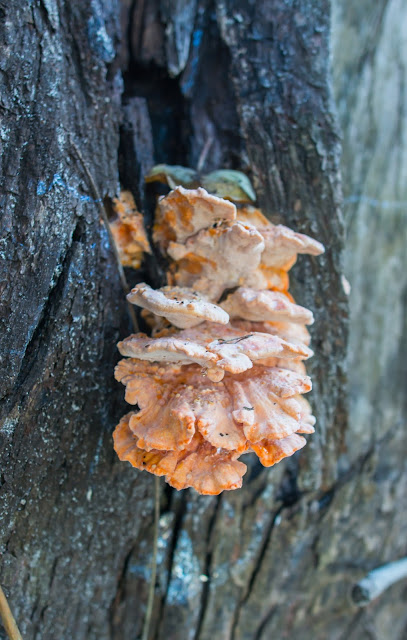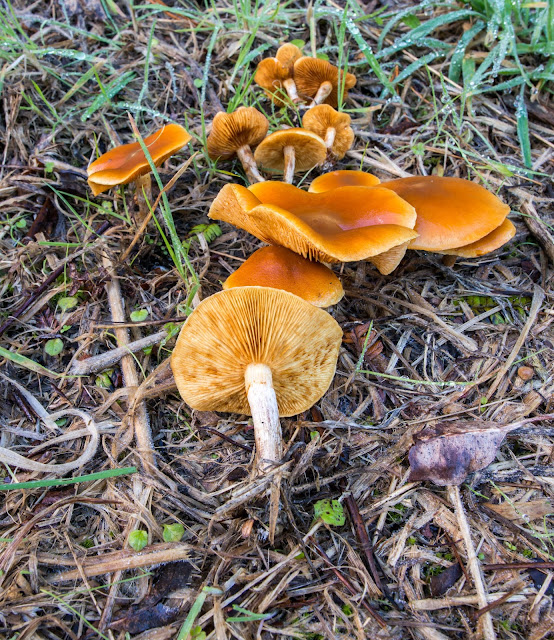Sunday, January 15, 2017
Yule Log 2017
Another year, another cold winter, and another Yule Log cake. This is a vanilla bisquit filled with a dark chocolate whipped ganache, frosted with coffee-flavored Italian buttercream. I made the traditional meringue mushrooms, and jazzed them up this year, with my attempt at five different species: Trametes versicolor, Amanita muscaria, Cortinarius iodes, Agaicus campestris, and Cantharellus cibarius. I ended up using colored candy melts for the colors and details, and the pine needle base was green candy covered All Bran cereal.
Monday, January 2, 2017
Wild Mushrooms of Polipoli Springs, Maui, Hawaii, 2016
Once a dense forest of Koa, mamane, and ʻohiʻa lehua, the Polipoli Spring State Recreation Area is composed of 10 acres of the Kula Forest Reserve. When the park was established many of the native trees were removed. However, in the 1930s the the area was reforested with pines, eucalyptus, tropical ash, cypress, China-fir, and redwood. Due to the elevation (6,200 feet), Polipoli Spring State Recreation Area can actually get pretty cold (temperatures can reach freezing at night). When we headed up at 9 am, there was frost on the grasses and trees, and the mud puddles were crusted with ice. The Jeep was for the clearance and 4 wheel-drive needed to get through some of the holes in the dirt road, and some of the switchbacks at elevation without anything but sheer mountain out the window were a bit terrifying for me, but Robert was laid back about it all, and even had fun driving. We walked a 5-mile loop around a few trails, passing through dense stands of eucalyptus, thimbleberry thickets, assorted conifers planted in rows, into low-hanging clouds that would white out the trail, and by hills heavily blanketed in moss.
Before we got to the parking lot at the top of Polipoli, we passed a couple of familiar fungi on the drive up. First was a Laetiporus gilbertsonii, a relative of our eastern choice edible Laetiporus sulphureus, growing on eucalyptus. Even though it exuded juice when cut, it was as hard as wood. Due to its condition and suspicion in causing upset stomachs because of substrate, we didn't collect it for consumption. Then we passed some Hypholoma fasiculare growing roadside in some wood chips, another we recognize from our cooler, wet autumn season in Connecticut.
Starting out on the grassy portion of the trail, we ran into this butterscotch-colored beauty, possibly one of the Gymnopilus species? Here you can also see the just-melted dew covering the grass.
This is another one we recognize from home, Tricholomopsis rutilans, common name plums and custard. It is usually found growing attached to underground conifer roots, even though it appears to originate in grass.
Plenty of down dead wood up at Polipoli to support saprobic fungi. The cooler temperatures at elevation provided us with some familiar fungi we find in temperate Connecticut, like these two crusts, Phlebia tremellosa and Stereum hirsutum.
This puffball appeared similar to one of our pigskin puffballs, except for the extensive pseudo-stem. Our Mushrooms of Hawaii book IDs this as Scleroderma verrucosum due to the pink staining when the peridium is cut.
This brightly colored and small (most specimens were about 1 cm wide) polypore is the highly photogenic Favolaschia calocera. First observed in Madagascar, it has recently spread around the world and mycologists fear that it may be displacing native fungi species as it spreads through the paleotropics. Once Robert first noticed it on decayed twigs and fern stalks and we knew what to look for, we all suddenly spotted it often.
Chroogomphus sp. is a fungi we found a few years ago when making our first attempt to ascend to Polipoli (in a regular rental car, we never made it past the first 200' on the dirt road before bottoming out and turning around). Known to be associated with conifers in winter in California, this was likely introduced with the planted conifers. This may be C. vinicolor or C. rutilans, we didn't collect a specimen and scope the spores (hey, vacation!).
There are not too many Boletes in Hawaii, beyond a few Suillus and the elusive coconut-associated bolete, Pulveroboletus (Buchwaldoboletus) xylophilus. This Suillus pungens was a big surprise, as it isn't listed in the Mushrooms of Hawaii book, but it IS listed in the Mushrooms of the Redwood Coast, another book we own. This mushroom is normally associated with Monterey Pines, and was likely imported by accident with the conifer plantings done in the 1930's as well.
And as we were heading out of Polipoli in the late afternoon, Gillian asked a question from the back seat of the Jeep as we were driving along the dirt road that was cut into the grassy embankment, "Hey, isn't that a morel?". Haha, very funny, you can't fool us. BUT IT WAS. The weather at Polipoli mimics our southern New England weather in May very well: cold nights, warm days, and plenty of rain, so it makes sense. Morchella are reported in Hawaii, but fruiting in a scattered manner and difficult to see because of the dense undergrowth.
 |
| Planted conifers in Polipoli |
Sunday, January 1, 2017
Wild Mushrooms on Maui, Hawaii 2016
 We usually head out to a warm and tropical location during the middle of
a New England winter, so we did a little research into the fungi of one of our
destinations, Maui. A good deal of the fungi on
Hawaii are alien, introduced with vegetation and soil from other places,
therefore, many of the mushrooms are familiar to us. Only an estimated
17% of fungi are considered native Hawaiian species. Fungi can be found
almost all year in the subtropical environments, but the more abundant
season is from July through January. Fallen palm leaves and casuarina
needles, along with dead wood, coconut husks, lawns, and compost piles
of mulch are all good places to look for fruiting mushrooms. We
purchased Mushrooms of Hawaii by Don Hemmes and Dennis Desjardin to help us identify the mushrooms we found. On Maui, we visited the very wet area of Hana, and took the walk to Honolua Bay through a very wet forest gully.
We usually head out to a warm and tropical location during the middle of
a New England winter, so we did a little research into the fungi of one of our
destinations, Maui. A good deal of the fungi on
Hawaii are alien, introduced with vegetation and soil from other places,
therefore, many of the mushrooms are familiar to us. Only an estimated
17% of fungi are considered native Hawaiian species. Fungi can be found
almost all year in the subtropical environments, but the more abundant
season is from July through January. Fallen palm leaves and casuarina
needles, along with dead wood, coconut husks, lawns, and compost piles
of mulch are all good places to look for fruiting mushrooms. We
purchased Mushrooms of Hawaii by Don Hemmes and Dennis Desjardin to help us identify the mushrooms we found. On Maui, we visited the very wet area of Hana, and took the walk to Honolua Bay through a very wet forest gully.Some of the most stunning finds were boring old polypores! These Microporus affinis are found on fallen branches in wet, often tropical areas. This fan-shaped bracket has a velvety, ridged cap with concentric zones of brown, red, yellow, blue, orange, and black and often have a zone of green algae. On the underside of the cap are very small white pores, best viewed with a hand lens. Distinctive characterisics for this species are the saucer-shaped depression in the cap near the stem, and the very short, lateral, black "foot". We successfully collected and dried several specimens, and they retained most of their color. A few of these were as large as my hand.
This is another, albeit less exciting, polypore showing the upper cap surface and the pores. We don't really know where to begin with its identity.
These two black blobs on dead wood are Ascomycota, and look very similar to species we have growing here in temperate Connecticut. The round one is a species of Daldinia; we didn't bring along any KOH to test for staining to try to narrow it down further (darn TSA and all those liquid/chemical regulations!). The finger shaped one is one of the many Xylaria.
This LBM is a sweet example of Gymnopus menehune. In Hawaiian mythology, the Menehune are said to be a people, sometimes described as dwarfs in size, who live in the deep forests and hidden valleys of the Hawaiian Islands, far from the eyes of normal humans. Their favorite food is the maiʻa (banana), and they also like fish. These gilled mushrooms are fairly common, and we came across many groupings of them in December.
It is easier to spot these bright polypore brackets in a forest than the duller brown ones. These were the very abundant Pycnoporus (Trametes) sanguineus, a tropical version of the Pycnoporus cinnabarinus we have in Connecticut. The pore surface is also bright cinnabar-red and the top surface of the caps is zoned in mixed shades of oranges and reds. Some folks collect these to dye textiles. From Wikipedia: Medicinal uses of P. sanguineus help relieve symptoms of the following diseases: arthritis, gout, styptic, sore throats, ulcers, tooth aches, fevers, and hemorrhages. P. sanguineus also displays numerous anti-bacterial properties against E. coli, K. pneumoniae, P. aeroginosa, S. typhi, and S. aureus by inhibiting specific metabolic pathways. Currently, P. sanguineus if being used in medicine for the absorption of certain heavy metals contained within the blood stream.
Here are a trio of jelly fungi. Even in Connecticut they pop out after it rains, and it certainly has been a rainy year here on Maui. We didn't identify he top, amber jelly. The second, white jelly is Tremella fuciformis. It is widespread, especially in the tropics, where it can be found on the dead branches of broadleaf trees. This fungus is commercially cultivated and is one of the most popular fungi in the cuisine and medicine of China. Tremella fuciformis is commonly known as snow fungus. The third, orange jelly is likely Dacryopinax spathularia, another edible, yet small fungi specimen. We found it twice, once growing from a wooden rail, and again growing from the side of a wooden house!
This is a colony of small, crumbly fungi is Coprinellus disseminatus. They don't deliquesce like other members of the inky mushroom group, they just get darker and crumble up. One log section can hold thousands, in different stages of growth from pins, to babies, beautiful white caps, and older, darkening caps. Gillian calls them "ghost mushrooms" because they look like white versions of the ghosts from Pac-man.
Subscribe to:
Comments (Atom)
































